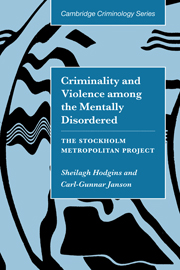Book contents
- Frontmatter
- Contents
- List of figures
- List of tables
- Preface
- Introduction
- Chapter 1 Research on the criminality and violence of the mentally ill
- Chapter 2 The longitudinal approach
- Chapter 3 Swedish society and Stockholm: the cohort and its context
- Chapter 4 Criminality
- Chapter 5 Explanations of the criminality of the mentally ill
- Chapter 6 Early and late-starters
- Chapter 7 Conclusion
- References
- Index
Preface
Published online by Cambridge University Press: 22 September 2009
- Frontmatter
- Contents
- List of figures
- List of tables
- Preface
- Introduction
- Chapter 1 Research on the criminality and violence of the mentally ill
- Chapter 2 The longitudinal approach
- Chapter 3 Swedish society and Stockholm: the cohort and its context
- Chapter 4 Criminality
- Chapter 5 Explanations of the criminality of the mentally ill
- Chapter 6 Early and late-starters
- Chapter 7 Conclusion
- References
- Index
Summary
This book illustrates how an investigation of a birth cohort followed for thirty years, which was designed principally as a study of inequality and social deviance, was used to examine the relation between the major mental disorders and criminality. The findings presented here, plus those found in many other publications from Project Metropolitan, demonstrate the wealth of knowledge that can only be gleaned from tracking individuals over their life-span. The present volume also illustrates how information routinely collected by governments can be de-identified and used in a cost-effective manner to study questions which have important implications for social policy and as well for advancing our understanding of human development. The results reported here also demonstrate how the data from such a project can be used to answer questions that were not even thought of at the time the project was designed. The Scandinavian tradition of supporting and maintaining longitudinal investigations of cohorts which integrate information from registers with information collected from the subjects themselves is to be praised. This tradition, now being slowly adopted elsewhere, has proven repeatedly to produce a wealth of knowledge that cannot be obtained in other ways. (See, for example, C. G. Janson (ed.), Some Swedish Longitudinal Studies in the Behavioural Sciences, 2000.)
The criminality of persons who suffer from major mental disorders is now a social problem confronting governments in the Western industrialised countries.
- Type
- Chapter
- Information
- Criminality and Violence among the Mentally DisorderedThe Stockholm Metropolitan Project, pp. ix - xiiPublisher: Cambridge University PressPrint publication year: 2002

